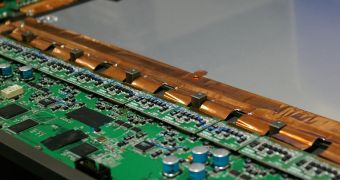The Korean company Samsung, besides being the world's largest manufacturer of TFT-LCD panels, is also involved in quite a lot of various other market segments, including that of medical devices. And the company's latest announcement refers exactly to this specific domain, as it seems that ol'Sammy has completed development of a very advanced flat panel X-ray detector (FPXD) for radiology machines, in collaboration with Vatech Ltd, a Korean medical machinery manufacturing company.
An X-ray detector is an elaborate imaging sensor that converts invisible X-ray images into digital signals, which are then instantly transformed into pictures. Today, the medical profession still relies primarily on costly, plastic-based analog film for X-ray photography applications, which can take an excessively long period of time to develop in many medical situations. However, things are about to change, as Samsung's new X-ray detector can save medical labs considerable time and money because no film or development process is needed.
The new Samsung FXPD technology has virtually an endless range of applications beyond conventional X-ray systems. For example, it can be adopted for more advanced diagnostics such as CAT scans, for building inspections (scanning rebar structures, etc.) and for airport security scanners. The new FPXD measures 45 centimeters (cm) wide x 46cm high (or 61cm diagonally) and boasts a 3072 x 3072 (9.4 megapixels) resolution providing ultra-high definition images, which can prove critical for determining a patient's diagnostic.
To create its FPXD, Samsung attached photodiodes to a TFT substrate that was produced using its proprietary amorphous silicon technology. The X-rays are detected photon by photon and then converted into visible light, which in turn is converted to electrical signals that can be displayed as diagnostic images on a flat panel screen. In addition, Samsung has created an image enhancement function to eliminate most digital image noise interference to provide the highest radiographic sensitivity in the industry.
According to executive Vice President Yoon Jin-hyuk, chief of the Mobile LCD Division in the Samsung Electronics LCD Business, it is about time for the X-ray detector market to go fully digital: "The analog film camera market almost completely switched over to digital cameras within a decade. The X-ray detector market should move even faster and become completely digitized within a few years."
According to Samsung, the new panels will be available worldwide starting with next year's first quarter, which means that the first units will probably be arriving in hospitals towards mid-2008.
We are just a few, but there are many of you, Softpedia users, out there. That's why we thought it would be a good idea to create an email address for you to help us a little in finding gadgets we missed. Interesting links are bound to be posted with recognition going mainly to those who submit. The address is  .
.

 14 DAY TRIAL //
14 DAY TRIAL //